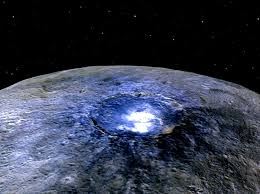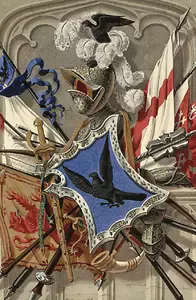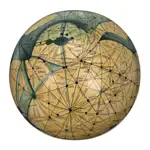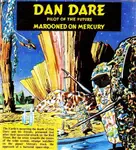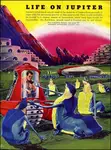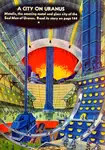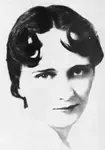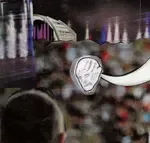what to see on
ceres
For a scenic browse, and an answer-page for Guess The World....
enclaves on ceres
...Almost centrally located in the Martian quarter was a glittering, garish locality where every diversion could be found. This was called Pulambar, after the great City of Pleasure at home on Mars.
Along the equator ran a strip of dry, hot sand, rusty red - an imported bit of the Martian desert. Across that sand-strip, to the south, a quarter was divided into four smaller areas, for Ganymede, Io, Europa and Callisto.
Above this quarter, tethered like a balloon by a gravity beam, hovered a sort of satellite. A twenty-mile globe had been artificially made of banded gas without and a solid core within. It was a miniature Jupiter, and some thought it the greatest wonder of all the Fair.
The northern quarter of the Eastern Hemisphere was Earth's, divided into many smaller districts for the wealth of various national and continental exhibits. Here, as with the Martian Pulambar, there was a central area, but it was for sports... Along the equator tossed the waves of an artificial ocean...
The southern shore, at the very equatorial line, was matted with Venusian jungle, under a localized fog...
Manly Wade Wellman, The Worlds of Tomorrow (Thrilling Wonder Stories, October 1940)
stowaway finds mystery on ceres
...Ronnie noticed something off to his right. It was a cleft in the rusty ground. The other members of the party were straggled out ahead of him now; for he hadn't been able to move quite as fast as they in his ill-fitting space armor.
The cleft offered no unusual promise. The men had ignored it. Nevertheless, youthful whim sent Ronnie hopping to its brink. Thick gloom enveloped its depths. But close to the torn lip of the cleft there were curious, broken fragments lying in the dust. They were flat and flaky, like pieces of shattered, red glass. As any adult would have done, Ronnie stooped and picked one of them up. Inside the thin, translucent texture of the shard, there slumbered a deep, bloody glow.
Ronnie wanted to yell out about his find to his brother up ahead; but something unfathomable restrained him...
Raymond Z Gallun, Red Shards on Ceres (Thrilling Wonder Stories, December 1937)
marooned on ceres
It was the thirty-ninth day, Earth time, since the Lady Betty's
departure. Pelican sat straddle-legged on the apex of a sixty-foot tor, the
highest piece of ground he had encountered, and surveyed the scene before
him.
Away to the brief, deeply curved horizon stretched a monotonous
landscape of dust, rocks and loam, molded into low hummocks and shallow
gullies, dotted here and there with tiny shrubs and berry-bearing bushes.
A heavy thump reached his ears, he turned his head, caught a
momentary glimpse of something falling, and heard a second thump. He
jumped to his feet, stared without avail, commenced running in the
direction from which the mysterious sounds had come.
Assisted by weak gravity, handicapped by thin atmosphere, he
bounded along in giant strides, his chest straining mightily. A gun whined in
a distant ravine; Pelican saw its thin, pale-golden beam angle to the sky.
Two figures—a woman and a uniformed man—sprang from the depression,
raced across his line of progress a quarter of a mile ahead. Four more
figures sprouted from the same spot and rushed after the fugitives.
"Pirates!" cried Pelican....
Eric Frank Russell, The Saga of Pelican West (Astounding, February 1937)
escape on ceres
…With infinite care I pushed open the closet door, stepped out, then slid the bolt again to make it appear that I was still a prisoner. On tiptoe I approached a window, raised it. Still no sound other than the hiss of the torch. I swung down to the ground, closed the window behind me, and ran toward the sleek silvery little space-ship.
The ice-covered plain was bitterly cold; I had neglected to put on one of the asbestoid over-suits. The deserted huts, the head of the mine shaft loomed like a row of dark specters in the wan starlight. And since the cold light of the stars was cast from different angles, double, triple and even quadruple shadows fell across the barren wastes. Bleak, desolate, to an earthman, but I was used to the cold Cerean scene. Great jagged pinnacles of rock stabbing like crooked daggers at the frosty sky; rounded meteor holes dug into the ground; occasional patches of pale ice-moss, dangling like white beards from the grotesque rocks; and beyond, the glistening plain, dropping away to a ridiculously close horizon. I gasped in the cold air as I ran, felt it bite my lungs. Without gravity shoes, I covered the distance to the ship in a dozen great bounding leaps…
Frederick Arnold Kummer, Jr., Star Pirate (Planet Stories, Summer 1940)
modestly inhabited ceres
…Between the orbits of Jupiter and Mars they made a most valuable economy by landing on Ceres, one of the largest of the asteroids, and travelling about fifty million miles on her towards the orbit of the Earth without any expenditure of force whatever. They found that the tiny world possessed a breathable atmosphere and a fluid resembling water, but nearly as dense as mercury. A couple of flasks of it form the greatest treasures of the British Museum and the National Museum at Washington. The vegetable world was represented by coarse grass, lichens, and dwarf shrubs, and the animal by different species of worms, lizards, flies, and small burrowing animals of the rodent type…
George Griffith, A Honeymoon in Space (1901)
>> Guess The World - Third Series
lungless creatures evolved on airless ceres
The space-dog stood three feet high at the shoulder. Its body was of dusty, mineraline gray flesh that had an inorganic look. Its four legs ended in heavy digging paws, and its mouth was furnished with great grinding tusks. It had no nostrils, for the creature was not an air-breathing animal.
It was, in fact, one of a unique species. The early explorers who first visited the asteroid Ceres had been amazed to find these creatures living on that airless little world. They were product of an evolution working without atmosphere, creatures able to assimilate the inorganic elements they dug from the ground, and consume them by a chemical process other than oxidization. They had dim telepathic powers by which their rudimentary minds communed.
Edmond Hamilton, The Three Planeteers (Startling Stories, January 1940)
>> Guess The World - Fourth Series
pirate city in a gorge on ceres
…A dark ragged terrain was spreading out below them. Then, Curt saw the place at last. A deep gorge, with cliffs towering up on either side. He’d only been here twice before in his life but he knew the place well.
He maneuvered into place, and the cruiser descended slowly on the under-hull repulse beam. Even Kraaz was puzzled now, as they went deep into this tiny world. Suddenly the scene widened. The terrain spread out again and lights leaped into view. They were in a vast hollow where a complete town nestled, concealed by the sheering black cliffs. They settle down onto a spaceport where a hundred ships rested.
“Welcome to Ceres,” Curt spoke dryly. “But I hope we won’t be staying long.”
…They stepped down into the thin atmosphere of Ceres' depths. Ships of all sizes and designs rested there in the vast hollow; for this was an outlaw base for pirates of all planets…
…They saw spacers of every description… but they failed to meet the description Curt was after. But suddenly, as they neared the edge of the hollow – he saw one…
…Kraaz had seen. Now he strode purposefully toward the side locks. It took all of Curt’s strength on his arm to stop him.
“Careful, man. Remember you’re on Ceres Base now.” Curt jerked his head toward the lights of the town. “The owner must be around somewhere – let’s go find him.”
Kraaz nodded. They walked toward the single sprawling street of Ceres Base. Sounds of revelry reached them, guttural laughter and curses and the click of gambling wheels. Once they saw a thin, blue flash of an electro-pistol. That was the only law here, and life was cheap among these cutthroat pirates…
Henry Hasse, Trail of the Astrogar (Amazing Stories, October 1947)
>> Guess The World - Fifth Series
martians reconnoitring ceres
Owing to the slightness of the gravity given the Martians by their apparatus, progress was slow. Extreme care had to be taken to avoid dangerous falls among the giant boulders and cliffs. Crevices, wide and apparently bottomless, were everywhere. It was necessary to keep out of the shadows, for everything in them was as black as Erebus. They spread out and made a wide circle, keeping in touch with each other constantly. But to all appearances the planet was as virgin as at it birth. It was hard to believe it to be inhabited, and they began to wonder if they had not been the dupes of a cleverly arranged optical illusion.
They moved with extreme caution, and rather slowly and awkwardly, owing to the impeding cumbersomeness of the envelopes. The slightness of the gravity of Ceres, combined with that added by their apparatus, did not trouble the Martians, for it was about normal to them. They held themselves constantly alert for signs of the enemy, picking their way around the pits and holes made by falling aerolites. At times they had to leap across great bottomless fissures. At last they found their progress barred by a precipitous gorge, several hundred feet in depth, and apparently miles in length. Its depths lay in profound blackness. They halted on an overhanging ledge and spent some time examining this magnified crack in Ceres, for it was little more than a wide cleft between rock walls, with nearly perpendicular sides. At length Maltapa signed to Orala that he wished to talk.
He came close to his assistant, took up a small tubelike appendage hanging from the headpiece of his ether envelope, and clamped it with great care to a similar one in Orala’s envelope, forming a hermetically sealed passage between the two headpieces.
“Don’t appear to notice, Orala,” he cautioned, “as we are probably watched, but take a good look well down the opposite side there on the left just in the edge of the shadow. I thought I saw some sort of movement.”
Orala could not make out anything, and they were just about concluding that Maltapa had been mistaken, when, without warning flash or sound there was a terrific jar like a small earthquake, and a cloud of dust and pulverized rock enveloped them. The Martian Chief and his assistant leaped back instinctively from the edge, almost tearing asunder their speakers.
When they had recovered themselves and the dust cloud had cleared, they saw that a part of the ledge on which they had been standing had been clipped off sharply and precipitated down the wall of the gorge. Where there had been five Martians on the lip of the declivity, there were now but four.
“Damn that cursed aerolite!” exploded Maltapa. “It's lost us a good man!”
Detaching the speaking tubes, Maltapa waved the others farther back. He examined the ledge with care, selected a solid portion, and crawled forward on all fours to the very edge. Long and earnestly he swept the declivity below with his glass, until it came to rest on a particular spot. He signed Orala to him and attached the speakers.
“He’s lying about half way down there, poor devil! See him? He’s lying sprawled out in a sort of hollow just above that great pile of boulders. See him? Evidently the aerolite did not hit him. If it had, there wouldn’t be anything left to see.”
Aladra Septama, The Beast-Men of Ceres (Amazing Stories Quarterly, Winter 1929)
>> Guess The World - Fifth Series
problems of siting an observatory on ceres
…Ryger
consented to talk of Ceres after listening to the low murmur of the other
voices. There was the problem there of
the two-hour rotation period, which meant that the stars whipped across the sky
at an angular velocity twelve times that in Earth’s sky. A net of three light scopes, three radio
scopes, three of everything, caught the fields of study from one another as
they whirled past.
“Could you use one of the poles?”
asked Kaunas.
“You’re thinking of Mercury and the
Sun,” said Ryger impatiently. “Even at
the poles, the sky would still twist, and half of it would be forever
hidden. Now if Ceres showed only one
fact to the Sun, the way Mercury does, we could have a permanent night sky with
the stars rotating slowly once in three years…”
Isaac Asimov, The Dying Night (Fantasy and Science Fiction, July 1956)
>> Guess The World - Sixty Series
Note from Zendexor: According to NASA's website Ceres takes about 9 hours, not 2, to rotate. And the orbital period is 4.6 years, not 3. It would be mildly interesting to know how Asimov got it wrong.
a fertile plain on ceres
The astronauts gathered their backpacks, filled with
weapons, work utensils, tools, tents, and other gear, and moved away from the
airship.
The desert plain wasn't too large. It ended in a sandy
promontory very similar to the Saharan dunes. From the summit, the expedition
members were able to contemplate a marvellous landscape. The most fertile human
imagination would have been incapable of describing it. An immense plain
covered with bushes thickened with flowers of a thousand different colours.
From time to time, the polychromatic and fragrant savannah broke its monotony
by raising toward a clear sky the tops of towering trees laden with strange
fruits.
Professor Morgan exclaimed enthusiastically:
"I've never seen anything so beautiful. This asteroid
perfectly lives up to its name: Ceres. It seems like the work of witchcraft.
More than a thousand years ago, in 1801, a wise astronomer from that distant
era, working in his observatory, discovered this planetoid for the first time
and named it Ceres, goddess of the fields. If he had suspected that this
was indeed the case... But no, he could not have imagined that the star he had
named after her would be a true paradise for plants. I am certain that if
plants, which don't have souls, had one, this place would be their heaven”.
None of the astronomer's companions answered him. They were
too impressed by the beauty of that vast plain.
Leo MacDonal / Fernando Marimón Benagues, The Worm-Men of Ceres
(Los Hombres Gusano de Ceres), 1962
>> Guess The World - Sixth Series
Comment from contributor Lone Wolf:
Another example of the early Spanish SF written by the
writer Fernando Marimón Benagues under the quasi-English nickname "Leo
MacDonal" (sic! - without final "d"). As I understand, later he
also wrote a sequel to it, entitled "The Vampires of Death", but it
was of inferior quality. It seems this was the Spanish equivalent of the
American pulp fiction literature, a genre called
"bolsilibros", i.e. "pocket books", flourishing from 50s to
the early 70s, that is more or less quarter of a century after its American
prototype. Those were mostly plot-driven stories, fixed on action, adventure
and intrigues, not so much concerned with world-building, and thus in them the
planets are often just vaguely described settings without any relation to their
real equivalents or fictional literary images. The interesting in this example
is that the author derives the planetary character of the world from the
mythological archetype of its name, which is rarely the case, except maybe with
Mars and Venus.
Further note from Lone Wolf, 17 August 2025:
I noticed that for some reason the title of the novel is changed from
"The Worm-Men of Ceres" to "The World-Men of Ceres"
on the site (I guess this is due to the auto-corrector, which tends to
do such tricks). [Error now corrected - Z.] Those creatures, alluded thus in the title, are not
actually native to Ceres in the novel, but malicious life-forms
transplanted from Neptune, although almost nothing more is said about
the latter planet. As I said there are lot of stories, that consist of
adventures and intrigues, but not much world-building in this Spanish
pulp. Thus I came across stories set on Jupiter and Uranus (apart from
the classic locations of Mars and Venus, which are most common), but
they are mostly just a names without anything characteristic to them or
often just a vague description of the background. They can easily be
changed to any other planetary name in the text or even to a fictional
extrasolar planets and this would not affect the stories at all.
Note from Zendexor:
One could invent a name for this fault, of using planets as mere names with no meaningful characteristics. Must think about this. The most egregious example I can think of is E R Eddison's The Worm Ouroboros. Great book, but how ridiculous to call its scene "Mercury"!
